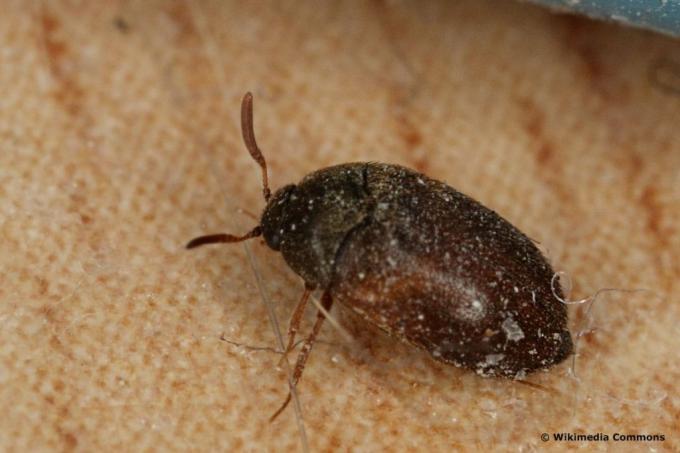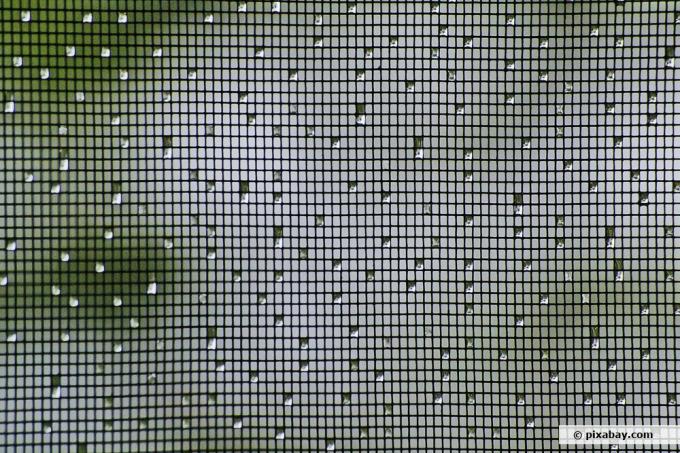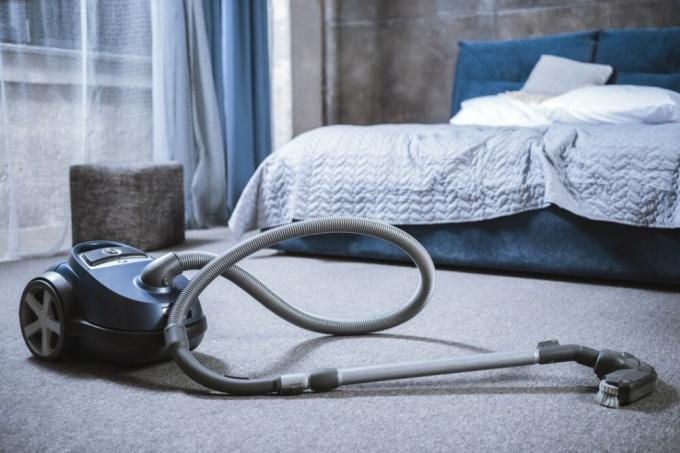
table of contents
- Recognize fur beetles and larvae
- prevention
- Combat with neem oil
- Vinegar essence
- Kieselguhr
- Vacuuming and cleaning
- heat
- cold
- cleaning
- Parasitic wasps
- Chemical methods
- frequently asked Questions
Fighting fur beetles and their larvae is possible by various methods. But which ones are effective and yet gentle? Our guide shows it and gives instructions.
In a nutshell
- Identifying the beetles early on is crucial
- Eating marks can be a clue
- Households with animals are particularly at risk
- natural and organic materials serve as food and brood substance
- toxic agents should not be used
Recognize fur beetles and larvae
The larvae of the carpet beetle, like the adult insects themselves, are gray-brown and have thick and dense hairs over their entire body. The beetles look like they have a furry coating on their shell.
However, the fur or carpet beetle doesn't get its name because of its appearance. Instead, it was named for its nutritional basics. This is animal material such as:
- feathers
- Fur hair
- hair
- leather
- Furs
- Wool
Typical signs of an infestation are:
- Feed marks on textiles
- bald spot on furs or animal exhibits
- Beetles or larvae in dark areas and cracks
- irregular holes

Assess the infestation
Before the fur beetles can be targeted, the infestation must first be determined and localized. Because although the insects and their offspring prefer to stay in certain areas, there are usually one or more central starting points. These are usually:
- dark corners
- Cracks, for example in parquet
- Cupboards and drawers
- Carpets
- Door strips
Controlling these can already help. However, it is better and more thorough to set up or attach appropriate glue traps with pheromones. On the one hand, this makes it easier to determine whether it is actually a fur beetle. On the other hand, the extent of the infestation can also be estimated.
Tip: The traps for fur / carpet beetles should be present during the entire period of control. This enables continuous monitoring and prevents further oviposition. However, the special pheromone traps do not help against the larvae.
prevention
Before there is a (renewed) infestation, a few simple preventive measures can be taken and means that are gentle and efficient can be used.

-
Fly screen: Windows and doors can be sealed with it so that no adult beetles get into the house or apartment. The costs are relatively low and assembly is easy. Another plus point is that the close-meshed gauze doesn't just keep these insects away. Flies, mosquitoes and moths can no longer penetrate either.
-
Controls: Behind furniture, in cracks in the parquet, seldom used cupboards and drawers - less frequented areas and animal materials are particularly vulnerable. For example, a collection of fur, hair and flakes of skin behind furniture is often used as a breeding ground. Rolled up carpets with natural fibers in the attic can also fall victim to the pests, like the seldom worn leather shoes. Leather-bound books and stuffed animals should therefore be checked in the same way as fur collars.
-
Cleaning: Thorough cleaning in otherwise rarely used areas, such as vacuuming cracks and niches, helps to remove the pests' eggs. In addition, the insects are deprived of their nutritional basis and breeding grounds are eliminated. Alternatively, a steam cleaner can also be used.
- Safekeeping: Natural materials and textiles of animal origin should be washed thoroughly or sent to the dry cleaner before storage. They are also to be packaged airtight and securely. Boxes or envelopes with a vacuum valve are ideal for this.
Combat with neem oil
Neem oil can be dissolved in water to combat carpet beetles and their larvae. To do this, just add a few drops of the essential oil to lukewarm water and shake this mixture well in a spray bottle.
Affected areas can be sprayed with it to drive away or kill the beetles and larvae.
Vinegar essence
As with neem oil, a solution of vinegar essence and water can also be effective. However, this is only advisable if the materials in question are colourfast and can withstand contact with acids.
Tip: One part vinegar essence and four parts water are a good mix ratio. Again, a spray bottle should be used to distribute the solution thoroughly and evenly.

Kieselguhr
Diatomaceous earth is one of the methods that can also kill the eggs and larvae of the pests. You can distribute the fine mineral powder in cracks, niches and between fine fibers. It suffocates the parasites and can easily be sucked out again.
Note: Inhaling the powder is not advisable. Appropriate protection is therefore useful.
Vacuuming and cleaning
Thorough vacuuming also helps fight the bacon beetle insects. This does not only apply to the floor or the area behind cabinets.
Upholstered furniture and carpets should also be cleaned thoroughly to control the fur beetles and their offspring. In the case of already heavily infested and damaged furniture or home textiles, on the other hand, we recommend that you dispose of it quickly.
heat
Both eggs and larvae and the beetles themselves can be killed by heat. For this, however, at least 60 ° C must prevail for at least one hour. This condition can be achieved by washing, baking in the oven, putting it in a sauna, dry cleaning or a steam cleaner. However, this is only possible with materials and objects that can withstand the temperature.
cold
Since many of the measures are effective but the fur beetle eggs can survive for several months, cold should also be used in the fight. For this purpose, the objects in question are frozen at -18 ° C for at least three days. The measure should be repeated so as not to risk re-spread.
cleaning
Cleaning with a vacuum cleaner is a good start when the container is emptied or the dust bag is thrown away. In addition, you should move your cabinets and clean the floor behind them.
Other useful methods of cleaning are:

- use dry cleaning
- Use steam cleaner
- Wash textiles as hot as possible and several times
The less hair, skin flakes and fur are found, the lower the risk of the beetle spreading. Regular cleaning is therefore useful and also prevents moths and other pests, among other things.
Parasitic wasps
Ichneumon wasps to control fur beetles should only be used if the area is safely closed or outside. The natural predators also eliminate the larvae, but are not enough on their own to kill the eggs.
Chemical methods
Biocides and insecticides can of course also be used. However, they should only be used if the other methods are not found to be effective enough. Because the means can harm the environment as well as one's own health and beneficial organisms.
frequently asked Questions
It is ideal to combine several means and measures with one another. Even after an infestation, for example, traps should be set up and bars installed as a preventive measure. This prevents further spread.
No. They are not dangerous to humans or pets. They only pose a risk for dead material of animal origin.
The adult beetles themselves only live about a month. However, the eggs and larvae can survive for up to three years. With twelve stages during development, the animals last a long time and can cause considerable damage. However, this only applies if no appropriate countermeasures are taken.


